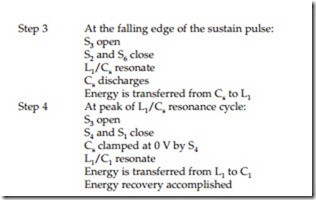Energy recovery
Stray capacitances, being of very small value consume negligible power that is normally neglected. However, with few million pixels and each pixel consisting of three cells, the total amount of stray capacitance of a PDP mounts up to a comparatively high level. In a VGA-resolution PDP for instance, the number of stray capacitors is 852 X 480 X 3 = 1.23 million. Coupled with high-amplitude drive pulses, power consumption by these stray capacitors becomes too large to be neglected. Hence the need to recover the energy stored in stray capacitors to be re-used for discharge.
The main energy consumption is in the sustain drive and hence the main energy recovery is carried out at these drives. However, energy recovery for the scan drive may also be implemented.
The principle of energy recovery is to use an inductor to resonate with the stray capacitance and at the moment when energy is transferred from the stray capacitance to the inductor, resonance is terminated by a con- trolled switching element, normally a MOSFET. Subsequently, the energy stored in the inductor is transferred to a PFC storage capacitance.
Figure 16.30 illustrates the principle of energy recovery. Cs is the stray capacitance between electrodes E1 and E2. C1 is the PFC storage capacitor into which recovered energy from the stray capacitor will be deposited. The sequence starts when the rising edge of the sustain pulse is applied between the sustain and scan electrodes (E1 and E2) and continues as follows:


